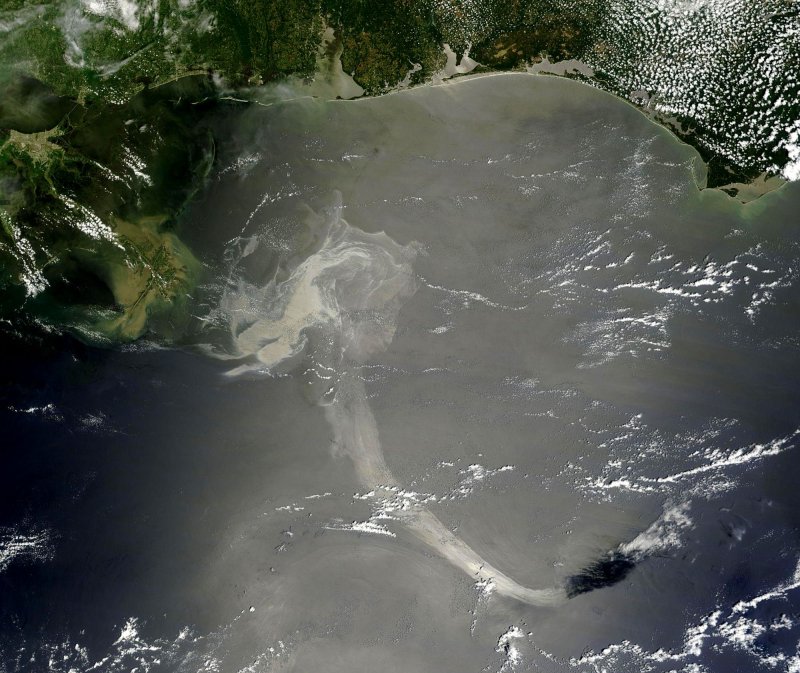NASA's Terra satellite captured a visible satellite image of the Gulf oil spill on May 17, 2010 from the Moderate Resolution Imaging Spectroradiometer Instrument on-board. The oil slick appears as a dull gray on the water's surface and stretches south from the Mississippi Delta with what looks like a tail. From top left to top right are the states Louisiana, Mississippi, Alabama and Florida. Scientists are worried that the huge plumes of oil could get into a current that would take the oil around Florida. UPI/NASA |
License Photo
WASHINGTON, April 7 (UPI) -- New containment technology unveiled by U.S. oil industry executives has led to eight new permits to drill in the Gulf of Mexico, despite uncertainty over whether the new control systems are actually capable of cleaning up a disaster such as last year's BP oil spill.
U.S. President Barack Obama's administration hadn't -- until now -- allowed new drilling in the gulf since the disaster that roiled the southern United States over the past year.
The two new systems, designed by Helix Energy Solutions Group and the Marine Well Containment Company, an industry consortium led by Exxon Mobil, have been touted as a solution to a contentious ban on offshore drilling and subsequent freeze on oil industry practices after the April 2010 Deepwater Horizon accident.
The U.S. House of Representatives Subcommittee on Energy and Environment met Wednesday to consider industry progress in the wake of the spill.
Both MWCC and Helix claim the new containment systems are ready for deployment, giving the U.S. Bureau of Ocean Energy Management, Regulation and Enforcement clearance to issue new permits, all of which cite one of the two systems as a way to control a deep-water well blowout.
According to new U.S. standards, oil companies must demonstrate spill containment capabilities, such as the new systems, before drilling in the Gulf of Mexico.
Five of the permits granted depend on the Helix Fast Response System, which is capable of operating at depths of 6,500 feet and can be deployed to the spill within 10 to 15 days, Cameron Wallace, Helix's director of public affairs, said.
"Depending on parameters of the well size it could be faster," Wallace said.
Subcommittee Chairman Rep. Andy Harris, R-Md., along with ranking member Rep. Brad Miller, D-N.C., asked about well blowout preventer failure and progress with a new design.
Helix President and Chief Executive Officer Owen Kratz said the lesson learned from the failed blowout preventer is that the industry and government can't rely entirely on prevention and must focus on containment for the inevitable.
Rep. Lynn Woolsey, D-Calif., pressed Kratz on why industry emergency preparedness and procedures weren't implemented before last year's disaster.
Kratz again cited an over-reliance on prevention following previous disasters.
"As the industry went deeper, the missing link between the inevitable spill and the cleanup was sort of overlooked," Kratz said.
Kratz, who praised his company for its critical involvement in the Deepwater Horizon cleanup, said the containment system is ready to go and noted that a more advanced system, which can operate at a depth of 8,000 feet, will be ready for deployment Monday.
Molly Macauley, a research director for an economic environmental think tank, Resources for the Future, which is funded in part by the U.S. Environmental Protection Agency, commended oil companies for their commitment to stepping up but emphasized her concern for future containment.
"Where I lose sleep is about the next battle. Again these ultra-deep-water depths exceed those where MWCC and Helix are prepared to service at the present time," she said. "In the event of a spill at these deeper depths, will we have to innovate on the fly again? What new science and engineering and state-of-the-art risk assessment do we need now? Who has this game plan?"
Macauley's central concern echoed the thoughts of the subcommittee's sentiment about research and development for future drilling.
"Are we innovating such that capacity to contain keeps pace with capacity to drill in increasingly extreme environments?" she asked.
Macauley's suggestions to enhance current drilling regulation and practices include continuing discussion with MWCC and Helix about plans for innovation, acting upon federal advisory groups' suggestions and changing the liability regime to risk-based liability caps for individual wells, similar to risk-based insurance policies.
Miller emphasized his concerns about developing containment systems operating at a depth of 10,000 feet when the industry was unable to control Deepwater Horizon, which operated at about 5,000 feet of water.
"I think the industry, if not prepared, has been preparing for quite awhile for 10,000 feet," Kratz said. "In fact 10,000 feet of water is pretty much of a standard basic design parameter for any service company or driller doing work in the deep water."





